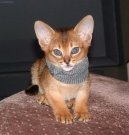Abyssinian (cat)The abyssinian is the short-haired version of the somali, with the exception of the coat length; they are the same cat.General: The Abyssinian is the short-haired version of the Somali, with the exception of the coat length; they are the same cat. The overall impression of the ideal Abyssinian is a medium to large cat, regal in appearance. Males are proportionately larger than females. The Abyssinian shows firm muscle tone and is lithe and panther-like in activity showing a lively interest in all surroundings. Head: The shape is a modified wedge with rounded contours as viewed from the front. In profile there shall be no flat planes, but a gentle transition between brow, nose and muzzle. There should be no evidence of a nose break. The head should be of ample length in general balance with the rest of the cat. In profile the skull is to show a gentle curve flowing over the head into an arched neck. The muzzle shall follow gentle contours in conformity with the head as viewed from the front and in profile. The chin shall be full, neither projecting nor receding, having a rounded appearance. Adult males may have jowls. The muzzle shall not be sharply pointed and there shall be no evidence of snippiness, foxy appearance or whisker pinch. Ears: Large, alert and moderately pointed, broad and cupped at base, Eyes: Almond shaped, large and expressive, neither round nor oriental and the slant is slightly toward the ear. Eyes accentuated by darker lid skin, encircled by a light colored area. Above each eye appears a short vertical darker pencil stroke amidst the lighter area. At the sides of each eye appears a curved darker pencil line as if a continuation of the upper eye lid. Coat: Dense and resilient to the touch, has a lustrous sheen and is fine in texture. The coat lies fairly close to the body, however, the undercoat should be adequate enough to avoid any evidence of slickness. The coat is longest at the spine, gradually shortening over the saddle, flank, legs and head. The coat is of medium length, double coated and long enough to accommodate at least four alternating light and dark colored bands. Body: Medium length, lithe and graceful, showing well-developed muscular strength without coarseness. The cat is solid to the feel, and the rib cage is rounded with no evidence of flat sides. The back is slightly arched giving the appearance of a cat about to spring. The flank shall be reasonably level without tuck up. Conformation strikes a medium between the extremes of cobby and svelte lengthy type. Proportion and general balance to be desired more than mere size. The legs are muscular without coarseness. The Abyssinian stands well off the ground and the length of the leg should be in proportion with the length of the body. The feet are oval and compact. When stroked the cat gives the impression of standing on tip toe. Toes; 5 in front and 4 in back. The tail is thick at the base, long and tapering. Pattern: Outer parts of the body covered by shorter hair shall have not less than one band of ticking. Darker shadings along spine allowed if fully ticked. The underside of the body, chest and inside of legs to be evenly shaded to harmonize with the main color without ticking, barring, necklaces or belly marks. Deeper and brighter tones are preferred. White or off white to be confined only to the upper throat area, lips and around nostrils on all colors except silver and silver derivatives. Tail to be tipped in same color as ticking without rings. Kittens may exhibit uneven ticking. Penalize: NFA: White locket or white anywhere on the body other than around nostrils, chin and upper throat area on all colors except silver and silver Accepted Colors:
Revised 5/94 Source: AACE >>> |
|
Photo to article Abyssinian (cat) : |
Free IQ test online
An Intelligence Quotient or IQ is a score derived from one of several different standardized tests attempting to measure intelligence. Although the term "IQ" is still in common use, the scoring of modern IQ tests such as the Wechsler Adult Intelligence Scale is now based on a projection of the subject's measured rank on the Gaussian bell curve with a center value (average IQ) of 100, and a standard deviation of 15, although different tests may have different standard deviations. The average IQ scores for many populations have been rising at an average rate of three points per decade since the early 20th century with most of the increase in the lower half of the IQ range: a phenomenon called the Flynn effect. It is disputed whether these changes in scores reflect real changes in intellectual abilities, or merely methodological problems with past or present testing. (Wikipedie)
IQ test lasts approximately 30 minutes and contains 40 questions !
In the IQ test you must focus on the maximum. Test questions are simple. In the IQ test may not use the calculator and paper.
Free IQ test online :
Banner on your page · Visitor's book · Besplatnye igry onlajn · Free games online · CZ Hry · RoboStav
Copyright (c) 2025 by TiptopGlobe.com. All Rights Reserved!
